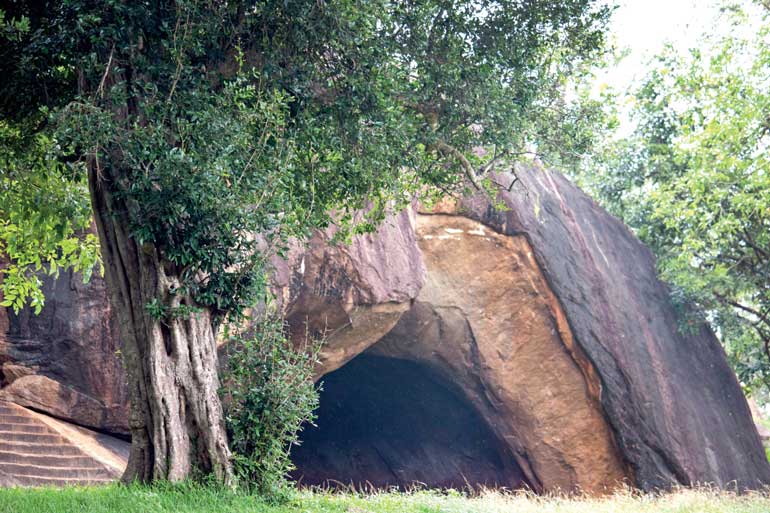Wednesday Dec 10, 2025
Wednesday Dec 10, 2025
Saturday, 20 January 2018 00:10 - - {{hitsCtrl.values.hits}}
Cave monastery of commoners
Traditionally, the term Vaishya was used to refer to the class of people in Indian society who worked in agriculture, trade and commerce. The Vaishya comprised of commoners from the business and merchant caste. Vessagiriya literally means “The rock shelters of the commoners”. Hence, it is commonly believed that the word Vessa-giriya derives from the Sanskrit Vaishya (commoner) and Giri (Mountain)

By Aysha Maryam Cassim
Vessagiriya has been closely associated with Isurumuniya and is considered one of the most important monastic establishments dedicated to the use of ascetic monks in the 2nd century B.C.
The rock shelters of the ‘commoners’
Traditionally, the term Vaishya was used to refer to the class of people in Indian society who worked in agriculture, trade and commerce. The Vaishya comprised of commoners from the business and merchant caste. Vessagiriya literally means “The rock shelters of the commoners”. Hence, it is commonly believed that the word Vessa-giriya derives from the Sanskrit Vaishya (commoner) and Giri (Mountain).
What we mostly know about Vessagiriya’s history comes from the 3rd century Brahmi inscriptions left on the rock walls by monks, patrons and their lay devotees. Ancient chronicles reveal that having ordained 500 priests into the priesthood at Isurumuniya, Arahat Mahinda who brought Buddhism to the country in 250 BC, came to Vessagiriya and ordained another 500 ‘vaisyas’. At present, the smoothened rock beds where the Arahat slept can be observed on the granite surfaces of the caves.
 The ‘Katara’ – Drip-ledged caves
The ‘Katara’ – Drip-ledged caves
Set among a group of mighty boulders, caves, pillars, ponds and shady trees, Vessagiriya is a retreat for peace-seeking pilgrims and nature lovers. The historical site can be found 600km south of Isurumuniya as a cluster of 200-odd monastic caves protected by drip ledges known as ‘Katara’. The Kataras have been hewn out of the rock to lead the rainwater away.
Through a rock-hewn staircase, one can reach the larger boulders which give panoramic views of Anuradhapura. On the top of the rocks, there are foundations of a small stupa and remnants of brick wall structures. The plaster which had been laid 2,000 years ago still seems to exist in patches even to this day.
It is estimated that there are 23 caves in Vessagiriya monastic site. In his book ‘Historical Guide to Anuradhapura’s Ruins’, Hubert E. Weerasooriya mentions that some of the best specimens of Veddah caves can be seen in Vessagiriya. But it’s debatable whether the caves were used by the ancient forest dwellers of Ceylon even before the monks took charge of the caves.
Apart from the drip-ledged caves, buildings constructed according to the traditions of “pancavasa”, ruins of a bodhighara, (stupa) a chapter house as well as two cave temples depicting ancient paintings are found in Vessagiriya. On the site exists a large cave on which there are traces of paintings – the painting of a female figure measuring about 3’ and another male figure.
Sigiriya and Vessagiriya
According to the Vessagiriya inscription belonging to the 6th century A.D. and by the Jetavanarama slab inscription of King Mahinda IV, it has been revealed that there was a close relationship between Sigiriya and Vessagiriya.
Close to a granite doorway is an inscription which reads “Isuru-Meni-Ro-Ipuluwan-Kasumbagiri-Vihare”. The Mahavansa further tells us that King Kasyapa gifted innumerable lands to Isurumuniya and Vessagiriya and built a monastery, naming it after his two daughters: Bo, Upulwan and himself, Kasumba.
During the periods of the reign of King Ilanaga (44-52 A.D), King Jetta Tissa 632 A.D and King Dathopa Tissa (659-667 A.D.) the monastery has been developed by the grants and donations provided by kings.
Hundreds of monks dwelt and meditated in Vessagiri caves centuries ago. As you walk along the series of stone steps, a wave of pungent odour hits you. The smell comes from the bat roosts in the rock crevices. Today the caves are a natural habitat for bats, birds, wasps and dogs.
While the trail to Vessagiriya caves is short, the surrounding scenery is dramatic. If it’s your lucky day, you might be able to spy a majestic peacock perched on a tree. The gravity-defying boulder overhangs are adorned with beautiful vines. The rocky cliffs bulging out above are intimidating and striking. For your safety, avoid venturing closer to the edge of rocky overlooks that are not fenced.
Vessagiriya is not so frequently visited like other sights in Anuradhapura. But a short excursion to Vessagiriya yields a spiritual experience in ancient Buddhist asceticism for the traveller who prefers some solitude in a cave retreat.
After spending an hour or two in the caves, one can envisage the sedentary life of hermits and monks who embraced the path towards peace.
